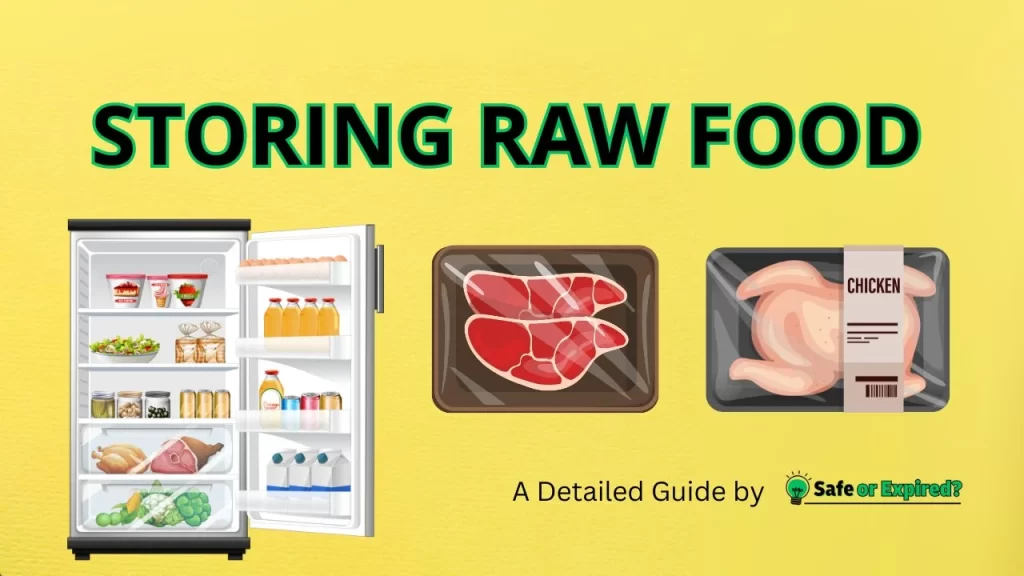Ever opened your fridge to find wilted veggies or questionable meat? Let’s change that! Storing raw food correctly is your secret weapon for keeping everything from avocados to zucchini vibrant and safe. Stick to the end, as this guide is packed with foolproof tips to transform your fridge into a freshness fortress!
Importance of Properly Storing Raw Food
Proper storage of raw food is essential to maintain freshness, prevent foodborne illnesses, and reduce waste. Correct methods ensure nutrients are preserved, enhancing food safety and sustainability. Furthermore, storing raw food correctly can also save you money by minimizing spoilage.
Prevents Foodborne Illnesses
The importance of storing raw food correctly cannot be overstated when it comes to preventing foodborne illnesses. According to the CDC, Raw foods, especially meats, seafood, dairy products, and even fruits, can harbor harmful bacteria, viruses, and parasites. These microorganisms can multiply rapidly under favorable conditions, posing a significant health risk.
By adhering to these specific storage guidelines, the growth of harmful microorganisms is inhibited, significantly reducing the risk of foodborne illnesses.
Maintains Nutritional Value
According to WHO, proper storage of raw food is vital for preserving its nutritional value. Unfortunately, nutrients can degrade when exposed to air, light, or incorrect temperatures.
For instance, many vitamins, such as vitamin C and some B vitamins, are sensitive to light and air exposure. Storing foods that are rich in these vitamins in airtight, opaque containers can help in preserving their nutrient content. Similarly, keeping fruits and vegetables in the crisper drawer of the refrigerator can maintain their freshness and nutritional value by providing an environment with optimal humidity and temperature conditions.
Preserves Taste and Texture
The sensory qualities of food, namely its taste and texture, are crucial for an enjoyable eating experience. These characteristics can be preserved through correct storage conditions. Fruits and vegetables, in particular, are sensitive to their storage environments. When stored at appropriate humidity and temperature levels, these foods can maintain their crispness, juiciness, and overall texture.
For example, leafy greens stored in a slightly humid environment within the refrigerator can stay crisp and fresh, avoiding the wilted, soggy texture that occurs when they’re left at room temperature or in overly dry conditions. Similarly, fruits like apples retain their crispness and flavor when stored in a cool, slightly humid environment, which mimics the conditions of a fruit cellar.
Extends Shelf Life
One of the most practical benefits of properly storing raw food is the extension of its shelf life. Correct storage conditions can significantly slow down the deterioration process, allowing us to enjoy our food for a longer period.
For instance, meats, when vacuum-sealed and frozen, can last for several months, retaining their quality and freshness. Similarly, grains and legumes stored in airtight containers in a cool, dry place can last for years without losing their quality.
To know more, check out this guide: Do Lentils Expire? The Reality.
Reduces Food Waste and Enhances Food Safety
An article in the Scientific World Journal states that proper storage practices serve a dual purpose: they significantly reduce food waste and enhance food safety. This makes them crucial for both environmental sustainability and household economics.
When we store food like fruits and veggies in the right way, we can use all of what we buy. This means less food gets thrown away, saving us cash and helping the Earth, too. Throwing less food away means not as much trash goes to dumps, where it can make a gas that’s bad for the air.
Also, keeping food safe in the fridge or pantry means we’re less likely to get sick from bad germs. This is really important for foods that can make us sick easily, like chicken, fish, and milk. If we keep these foods cold enough, germs can’t grow. Plus, storing food the right way stops germs from one food getting onto another food, keeping us even safer from getting a tummy ache.

Regulates Ripening Process
Many fruits produce ethylene gas, a natural plant hormone that accelerates ripening. While this can be beneficial for ripening fruits to perfection, it can also lead to premature spoilage if not managed correctly.
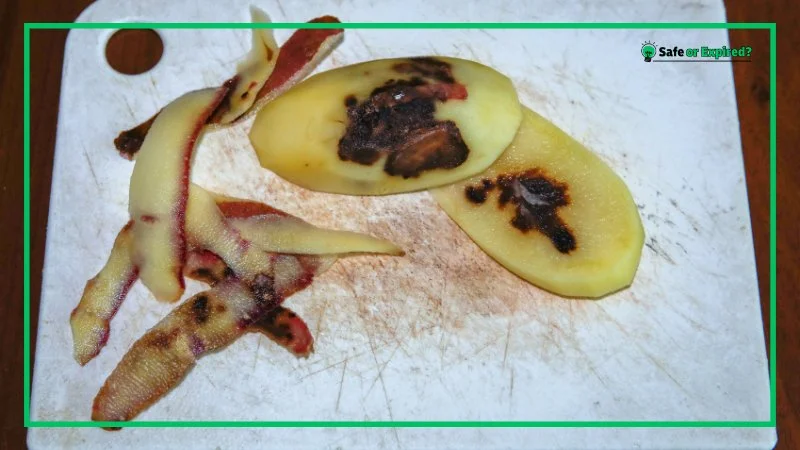
For instance, fruits like bananas, avocados, and tomatoes are known for their high ethylene production. If stored alongside ethylene-sensitive items like leafy greens or berries, the gas can cause these other foods to spoil more quickly.
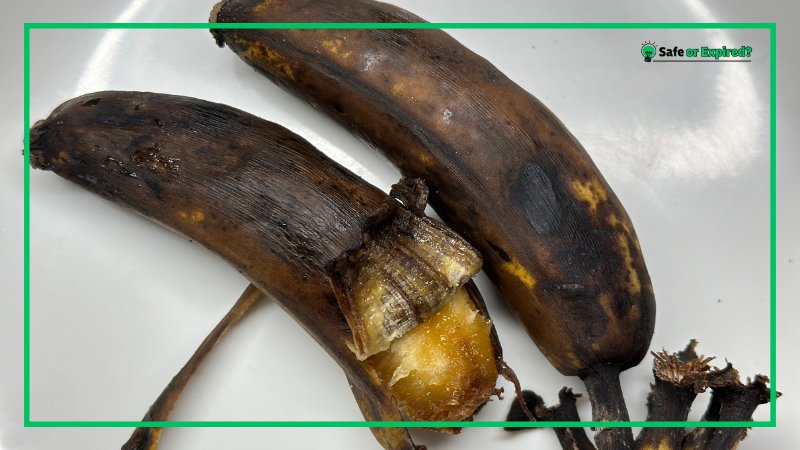
Proper storage, in this context, involves separating ethylene-producing foods from those sensitive to the gas. This can be as simple as storing them in different compartments within the refrigerator or using specially designed produce bags that absorb ethylene. Such measures help control the ripening process. This eventually ensures that fruits and vegetables maintain their quality for as long as possible.
Saves Money
Storing your food the right way isn’t just about keeping things neat; it’s a smart move that can save you a lot of money. When you make sure your food stays fresh for longer, you won’t have to throw out stuff that’s gone bad as often.
This means less wasted food and more money in your pocket. It’s not just about one piece of fruit or a block of cheese going bad. It adds up over time, and before you know it, tossing out spoiled food is like tossing out cash.
Take cheese, for example. If you don’t store it right, it can get moldy or dry out pretty fast. But when you store it properly, it stays good for a much longer time, saving you from having to buy new cheese too soon.
This is true for all sorts of food, from dairy and meats to fruits and veggies. By keeping your food in the right conditions, you’re actually saving money by cutting down on the need to buy new groceries all the time because of spoilage.
Ensures Legal Compliance for Businesses
For anyone running a food business, keeping things stored properly is super important, and it’s not just about being neat or efficient. It’s actually about following the law. There are lots of rules about food safety that businesses have to stick to.
These rules help make sure that the food we eat is safe. If a business doesn’t follow these rules, it could get into big trouble, like having to pay fines or even being shut down.
These food storage rules cover everything from how cold or hot food needs to be kept to how to label and rotate food so nothing that’s too old gets sold. For example, businesses have to keep raw meat away from food that’s ready to eat to stop germs from spreading, and they have to check that fridges and freezers are at the right temperature all the time. Following these rules isn’t just a choice; it’s a must-do for any food business that wants to stay open and keep serving customers.
Contributes to Sustainability
Smart storage habits make a big difference in protecting our planet by lessening the negative impact of throwing food away. When we keep our food fresh for longer, we’re not just saving snacks from the trash; we’re also cutting back on all the water, land, and energy that went into making that food.
Plus, we’re helping to reduce the amount of greenhouse gasses that get released when food is grown, shipped, and then tossed out. By just getting better at storing our food, each of us can play a part in making our food system more eco-friendly and join the fight against climate change and harming the Earth.
Improves Efficiency in Food Preparation
Keeping your food neatly organized and easy to reach can really transform how you prepare your meals. It turns cooking from a tedious task into something much simpler and even enjoyable.
Plus, when you have fresh fruits, veggies, and other wholesome foods right at your fingertips and ready to use, you’re more likely to pick those instead of reaching for processed snacks or ordering takeout. Good storage habits can make meal prep a fun part of your day and support a way of living that’s great for both your health and the planet.
How to Store Raw Fruits and Vegetables?
Store raw fruits and vegetables based on their ethylene production and sensitivity. Use the fridge crisper for humidity-sensitive items and keep ethylene-producing items away from others to prevent premature spoilage. Furthermore, it’s recommended to utilize breathable packaging to maintain optimal freshness.
Understand the Basics: Fridge or Not?
Fruits and vegetables have different storage requirements. Some thrive in cool, dark places, while others prefer the room temperature of a countertop.
- In the Fridge: Leafy greens, berries, and most vegetables like carrots and broccoli love the chill. It slows down decay and keeps them fresh.
- On the Counter: Tomatoes, bananas, and citrus fruits do better in a basket in your kitchen. Refrigeration can alter their texture and taste.
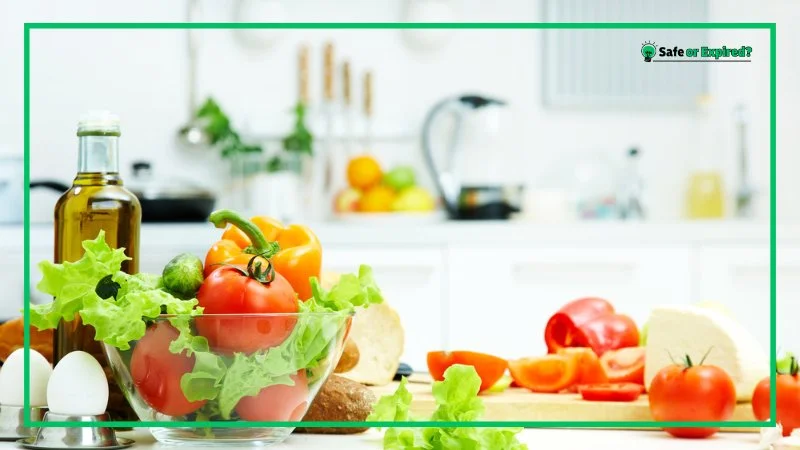
Keep Them Separated
Ethylene producers and ethylene-sensitive produce should live apart. Fruits like bananas emit ethylene, a natural ripening agent. This can cause nearby ethylene-sensitive vegetables like potatoes and leafy greens to spoil faster.
- Tip: Use separate drawers in the fridge or different areas in your kitchen to store these groups apart.
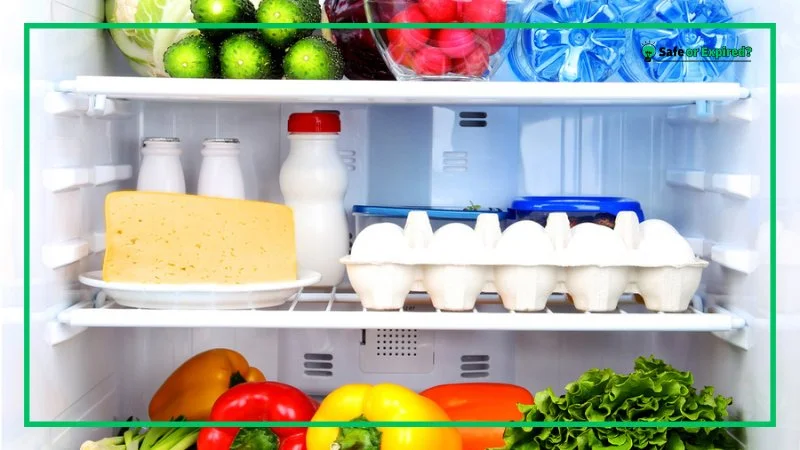
Humidity Matters
The crisper drawer in your refrigerator isn’t just a fancy shelf. It’s designed to maintain a different humidity level than the rest of your fridge, which is crucial for certain fruits and vegetables.
- High Humidity: Best for leafy greens and vegetables that wilt. Think spinach or arugula.
- Low Humidity: Ideal for fruits and veggies prone to rotting, like apples and avocados.
In addition to proper packaging and storage conditions, using advanced postharvest technologies can also effectively manage quality loss due to improper humidity levels. Techniques such as active packaging and modified atmosphere packaging (MAP) can significantly enhance the shelf life of fruits and vegetables by controlling the moisture and gas composition around the stored produce (MDPI).
Ventilation is Key
Some fruits and vegetables need to breathe more than others. For example, mushrooms fare best in a paper bag. This bag allows air to circulate and prevents them from getting slimy.
- Tip: Don’t wash produce before refrigerating it, as the extra moisture can hasten decay. Instead, wash it right before you’re ready to use it.
Use Special Containers
Investing in produce-saving containers can be a wise decision. These containers often allow for adjustable humidity and provide adequate airflow, which can extend the life of your fruits and vegetables significantly.
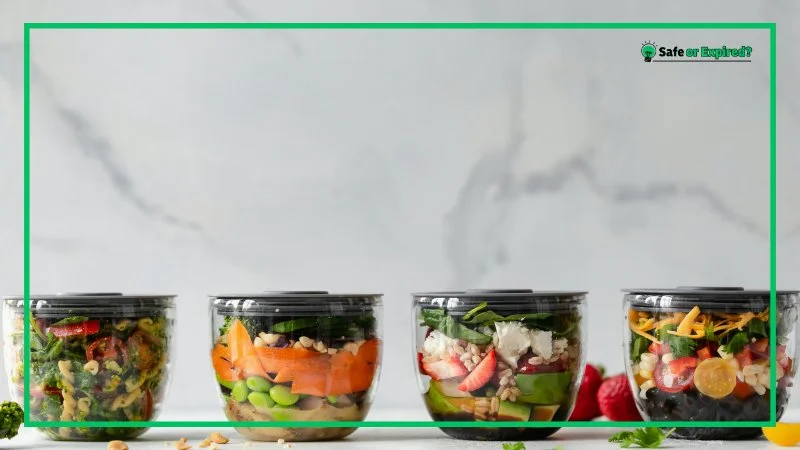
Here’s an example. Products like the OXO Good Grips GreenSaver are designed to keep produce fresh longer by controlling humidity and ethylene gas.
Know When to Wrap
Some items do better when wrapped. For instance, wrapping celery in aluminum foil allows it to stay crisp and fresh for weeks by letting the ethylene gas escape while keeping the moisture in. Researches also indicate that you must package your food (to preserve it).
Timing is Everything
Plan your meals around the shelf life of your produce. Use berries and leafy greens within the first few days, and save hardier vegetables like carrots and cabbage for later in the week. If you’re interested, check out: Can you eat expired carrots or not?
Handling Overripe Fruits
Overripe fruits are not always a lost cause. Bananas that have turned too soft can be peeled, sliced, and frozen for smoothies or baking. Soft tomatoes are perfect for sauces.
The Freezer is Your Friend
Freezing is a fantastic option for extending the life of your fruits and vegetables. Blanch vegetables like green beans or broccoli before freezing to preserve texture, flavor, and nutritional value.

According to FAO, using new technologies and understanding how freezing and thawing work is important for keeping food quality high during storage. This includes improvements in quick freezing methods that help reduce ice crystal formation and maintain the food’s structure.
Stay Informed
Keep abreast of the latest research and recommendations on food storage. Organizations like the USDA provide valuable resources and guidelines that can help ensure you’re storing your produce in the best way possible.
Regular Check-Ins
Make it a habit to go through your produce regularly to check for any signs of spoilage. Removing one rotten apple can save the rest.
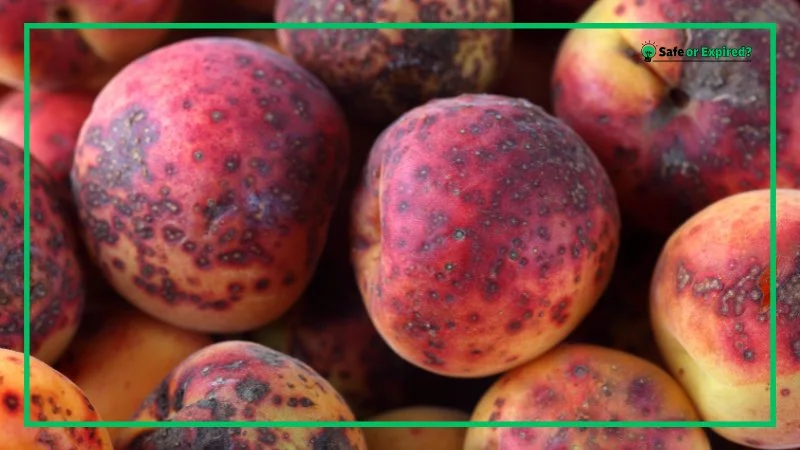
Embrace Imperfection
Sometimes, fruits and vegetables might look a little less than perfect but are still perfectly edible. Small blemishes or slight discolorations often don’t affect the overall quality or taste.
How to Store Raw Meat and Seafood?
Raw meat and seafood must be stored at or below 40°F to slow bacterial growth. Use separate containers to prevent juices from contaminating other foods, and consume or freeze them within recommended time frames to ensure safety and quality. Furthermore, use labeling to get an idea about when you stored the meat.
Temperature Control
Keeping raw meat and seafood at the right temperature is crucial. The USDA recommends storing raw meat and seafood in the refrigerator at around 41°F (4°C) or below or in the freezer at 0°F (-18°C) or below. This slows the growth of harmful bacteria.
- Quick Tip: Use a refrigerator thermometer to keep tabs on the temperature, ensuring it doesn’t rise above safe levels.
Separate Storage is Safe Storage
Raw meat and seafood should always be stored separately from other foods to prevent cross-contamination. This means keeping them in separate compartments or on the lowest shelf of your refrigerator to avoid any juices dripping onto other items.
Use It or Freeze It
Understanding the shelf life of raw meat and seafood can help you decide whether to refrigerate or freeze it. Most raw meats can be kept in the refrigerator for a couple of days, while seafood should be cooked within a day or two. If you won’t use it within these time frames, freezing is your best bet.
- Research Insight: According to the FDA, freezing meat and seafood properly can preserve its quality for months, depending on the type of meat or seafood.
Freezing Techniques Matter
When freezing raw meat and seafood, remove as much air as possible. Why? This will prevent freezer burn. Using vacuum-sealed bags or wrapping items tightly in freezer paper or foil can help maintain quality.
- Stats: Properly frozen meat can last up to 12 months, while frozen fish can maintain its quality for up to 6 months.
Thawing Safely
Thawing raw meat and seafood safely is as important as freezing them correctly. The best method is to thaw them in the refrigerator, not at room temperature. This keeps the meat out of the “danger zone” (between 40°F and 140°F). Note that bacteria multiply rapidly within this temperature range.
- Tip: Plan ahead and allow enough time for slow, safe thawing in the refrigerator. For quick thawing, use the microwave or place the sealed item in cold water, changing the water every 30 minutes.
Marinating with Care
If you’re marinating meat or seafood, always do so in the refrigerator, not on the counter. Marinate in a covered dish to avoid cross-contamination, and use the marinade once.
Recognizing Spoilage
Be vigilant about detecting signs of spoilage, such as an off smell, slimy texture, or discoloration in meat and seafood. When in doubt, throw it out. Remember that eating spoiled food can lead to foodborne illness. Here’s an example of the spoiled fruit:
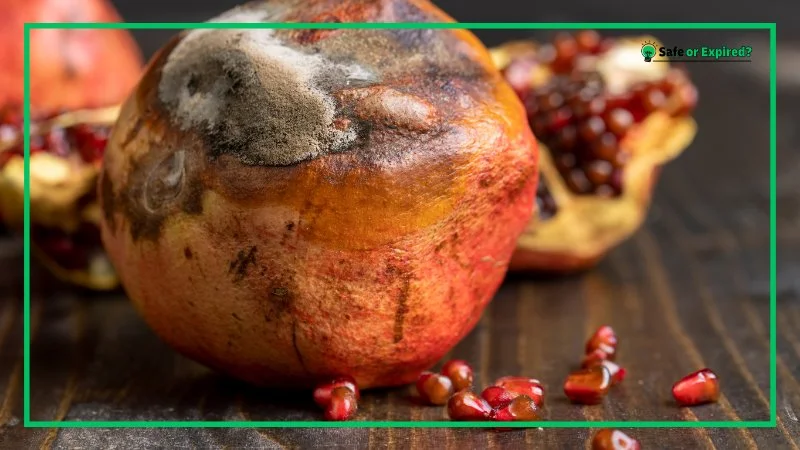
- Health Advice: Trust your senses. Spoiled seafood often emits a strong ammonia scent, a clear sign it’s not safe to eat.
Labeling and Rotating
Label all meat and seafood with the date of purchase or freezing. This “first in, first out” approach ensures that older items are used before they spoil or degrade in quality.
- Efficiency Tip: Keeping an inventory list on your fridge or freezer can help you track what you have and reduce waste.
The Role of Packaging
Invest in high-quality storage materials. For meat and seafood intended for the freezer, specially designed freezer bags or containers can provide the protection needed to maintain quality.
Consider Portion Sizes
Freeze meat and seafood in portions you’re likely to use for a single meal. This makes it easier to thaw exactly what you need, reducing the risk of having to refreeze anything, which can degrade quality.
Stay Informed
New storage technologies and materials are constantly being developed. You should stay informed about the best and latest practices for storing raw meat and seafood by consulting reliable sources like the USDA or FDA websites.
Troubleshooting Common Raw Food Storage Issues
To combat common storage issues, ensure proper temperature control, use airtight containers for freezer storage to prevent freezer burn, and separate foods to avoid cross-contamination. You should also regularly check for spoilage signs to keep your food fresh and safe.
Dealing with Spoilage
Spoilage is a frustrating reality of food storage, leading to wasted food and money. It often results from improper storage temperatures or cross-contamination.
- Solution: Ensure your fridge and freezer are set to the correct temperatures (40°F for the fridge and 0°F for the freezer). Store raw foods in clean, sealed containers or bags, and keep them separate from cooked and ready-to-eat items to prevent cross-contamination.
Battling Freezer Burn
While not harmful, Freezer burn can affect taste and texture. Here’s what it looks like:
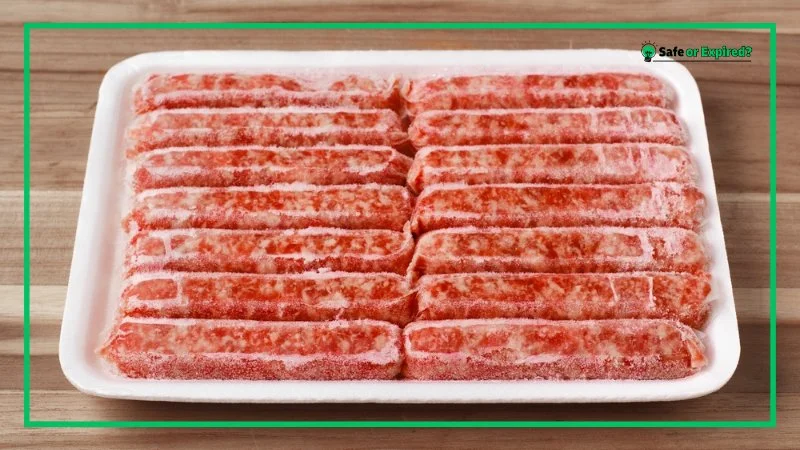
- Solution: Wrap foods tightly in freezer-specific materials like heavy-duty aluminum foil, freezer paper, or freezer bags. You must remove as much air as possible before sealing, which can also help prevent freezer burn.
Controlling Moisture Levels
Too much moisture can lead to mold growth on fruits and vegetables, while too little can dry out meats and cheeses.
- Solution: For fruits and vegetables, use the crisper drawer humidity controls to maintain the right environment. For meats and cheeses, ensure they’re wrapped tightly but not in a way that traps excess moisture against the food.
Avoiding Overcrowding
An overcrowded fridge or freezer can lead to uneven cooling and an increased risk of spoilage.
- Solution: Don’t overstuff your refrigerator or freezer. Ensure there’s enough space for air to circulate around each item, which helps maintain consistent temperatures.
Managing Expiration Dates
Keeping track of when food needs to be used can be challenging, leading to items being forgotten until it’s too late.
- Solution: Implement a first-in, first-out system in your pantry, fridge, and freezer. Label all items with their purchase or storage date and use older items before newer ones. Regularly check dates and plan meals around items that need to be used soon.
Addressing Odors
Unpleasant odors in the fridge or freezer can permeate other foods, affecting their taste and appeal.
- Solution: Keep a box of baking soda in your fridge and freezer to neutralize odors. Clean spills and spoiled food immediately, and regularly clean the interior. For this, use a mixture of water and baking soda.
Ensuring Proper Ventilation
Poor ventilation in storage areas can lead to ethylene gas buildup, speeding up the ripening and spoilage of fruits and vegetables.
- Solution: Don’t store fruits and vegetables in tightly sealed bags or containers in the fridge. Use perforated bags or containers with ventilation holes to allow ethylene gas to escape.
By addressing these common storage issues with careful planning, you can extend the life of your raw foods, reduce waste, and enjoy fresher, tastier meals.
Conclusion
Efficiently storing raw food is not just about prolonging shelf life; it’s about embracing a lifestyle that values nutrition, safety, and sustainability. By implementing the right storage techniques, you can:
- Ensure food safety by preventing the invasion of harmful bacteria and cross-contamination.
- Maximize freshness and nutritional value, preserving the taste and health benefits of your food.
- Reduce food waste, contributing to environmental sustainability and household savings.
- Enhance meal prep efficiency, making healthy eating more accessible and enjoyable.
- Adapt to best practices, staying informed about the latest storage solutions and technologies.
Following these points will not only elevate your kitchen game but also support a healthier, more sustainable approach to handling raw food at home.

